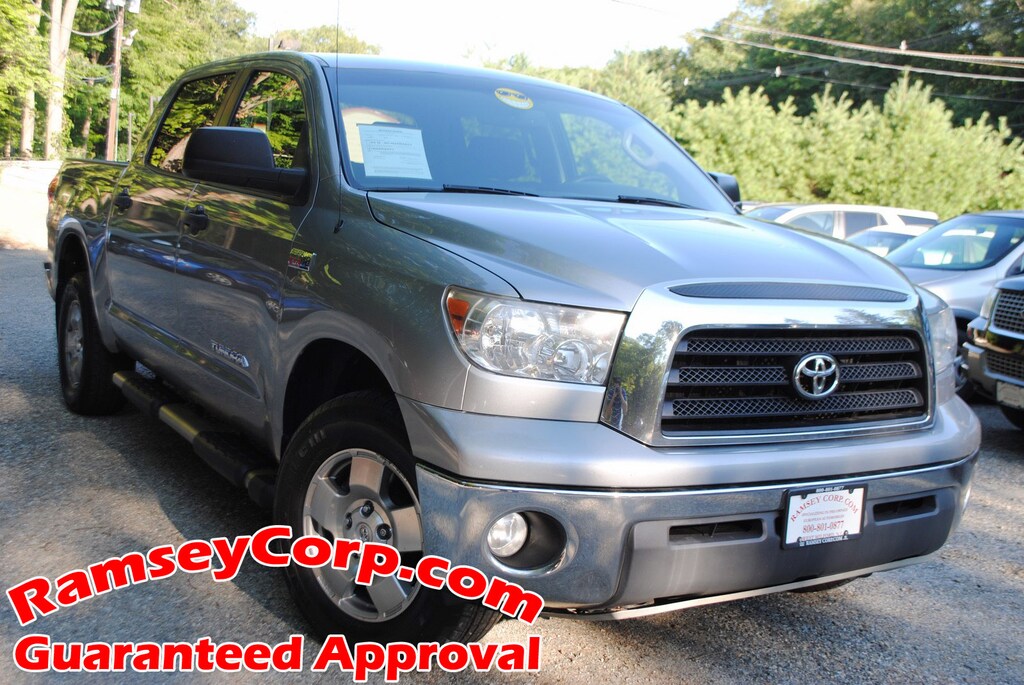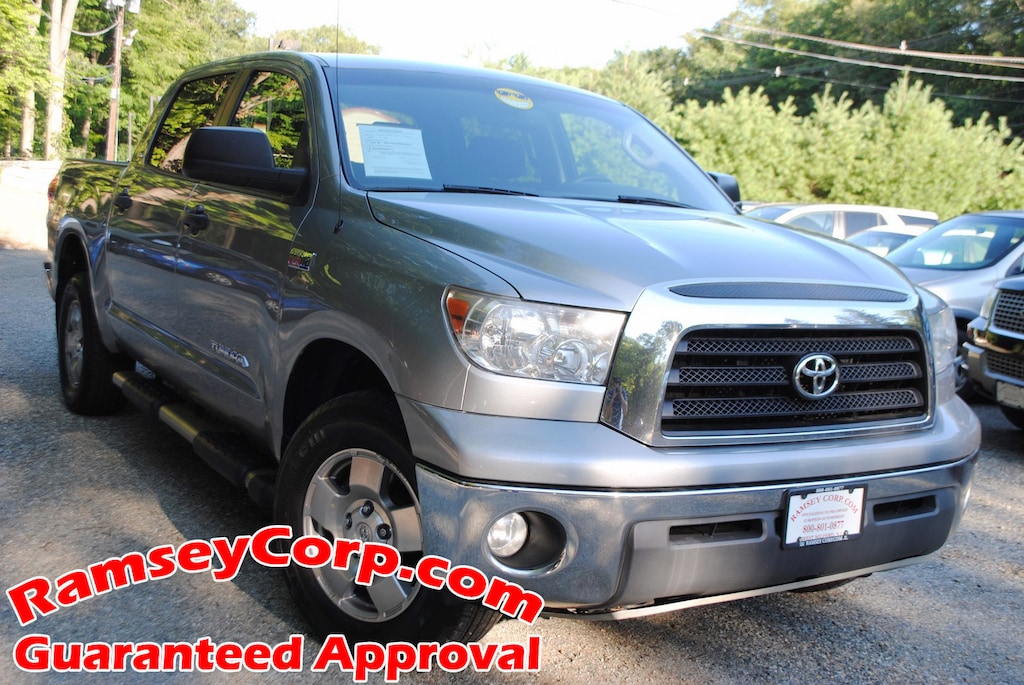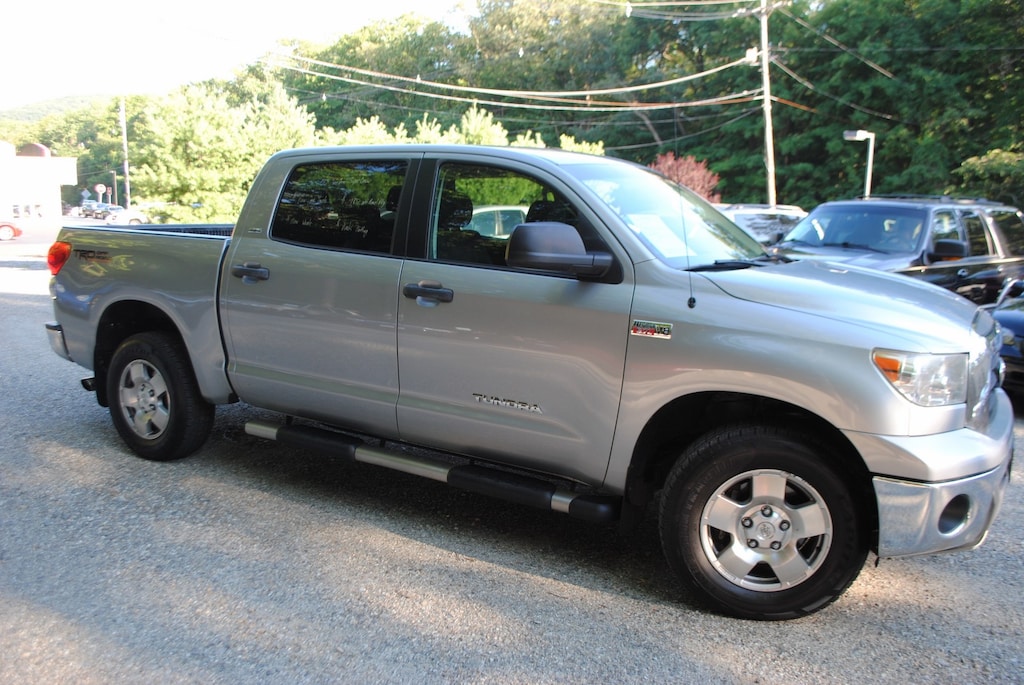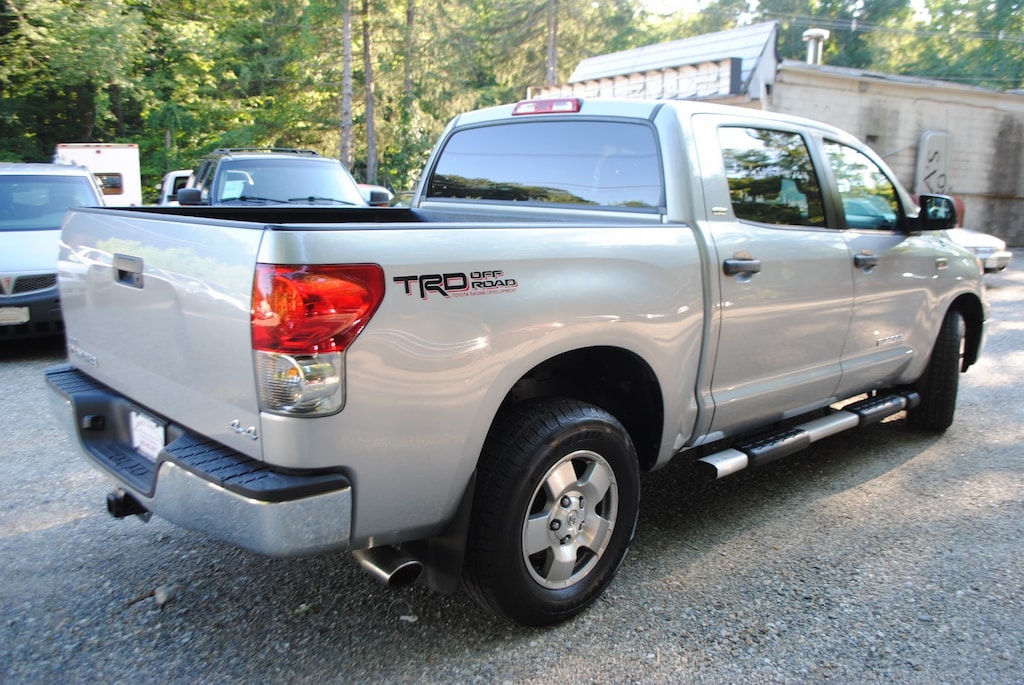
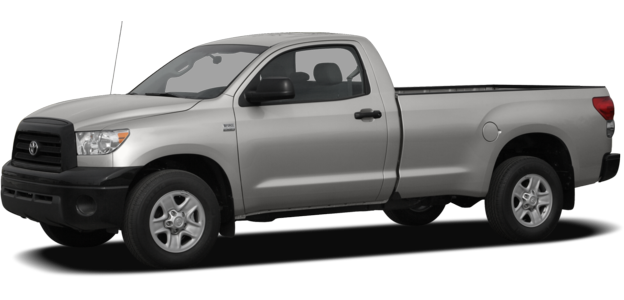
After a couple of almost-there models, Toyota has gone all out with a half-ton pickup: the second-generation 2007 Tundra rolling into dealerships right now. My overall impression of the Tundra is that it's not a game-changer, but it is a formidable player, and that's more than enough to satisfy buyers and threaten other truckmakers. From its high towing capacities and optional six-speed transmission to its safety and convenience features and roomy crew cab, the Tundra is a must-drive for anyone in the market for a full-size truck.
Exterior & Styling
The Tundra comes in three cab styles: regular, extended and crew, named Regular Cab, Double Cab and CrewMax, respectively. The Regular and Double Cab versions come with short or long cargo beds measuring 6.5 feet and 8.1 feet in length.
| Tundra Dimensions | |||||||||||||||||||||||
|---|---|---|---|---|---|---|---|---|---|---|---|---|---|---|---|---|---|---|---|---|---|---|---|
| Regular Cab (short/long bed) | Double Cab (short/long bed) | CrewMax | |||||||||||||||||||||
| Bed length (ft.) | 6.5/8.1 | 6.5/8.1 | 5.5 | ||||||||||||||||||||
| Overall length (in.) | 209.8/228.7 | 228.7/247.6 | 228.7 | ||||||||||||||||||||
| Overall width (in.) | 79.9 | 79.9 | 79.9 | ||||||||||||||||||||
| Height (in.)* | 76.0 | 76.0 | 75.8 | ||||||||||||||||||||
| Wheelbase (in.) | 126.8/145.7 | 145.7/164.6 | 145.7 | ||||||||||||||||||||
| Turning diameter (ft.) | 39.2/44 | 44/49 | 44 | ||||||||||||||||||||
| *Measurements are for lowest trim level and rear-wheel drive. Source: Manufacturer | |||||||||||||||||||||||
There are three trim levels: The Regular Cab DX is a stripped-down work truck with a black grille and grille frame, and black bumpers, side mirrors and door and tailgate handles. It can be upgraded to an SR5 by means of an option package that adds — among functional features — a chrome front bumper with a body-colored cap.
The Tundra resembles the Tacoma midsize pickup but with a taller, domed hood. Its most distinctive element is a black strip that spans the crest of the grille frame. I'm not sure I like it, but there it is. It stands out more on the body-colored grille surround that comes on the Sport Appearance Package, an option offered for Regular and Double Cabs.
In the Double and CrewMax styles, the SR5 trim level adds the chrome grille frame, and the chrome and body-colored treatment for the rear as well as the front bumper. The Limited trim level adds chrome to the grille's three crossbars, the door handles and the side mirrors, with the exception of the optional extendable mirrors offered for towing purposes. The Limited's front bumper is completely body-colored, and it's the only trim level with standard fog lights.
The standard wheels are 18 inches, in steel for the SR5 and alloy for the Limited. Twenty-inch alloys are optional.
Going & Stopping
Along with a V-6 that's standard on the Regular Cab and Double Cab, the Tundra offers two V-8 engines. The CrewMax doesn't come with the V-6.
| Tundra Engines | |||||||||||||||||||
|---|---|---|---|---|---|---|---|---|---|---|---|---|---|---|---|---|---|---|---|
| 4.0-liter V-6 | 4.7-liter V-8 | 5.7-liter V-8 | |||||||||||||||||
| Horsepower (@ rpm) | 236 @ 5,200 | 271 @ 5,400 | 381 @ 5,600 | ||||||||||||||||
| Torque (lbs.-ft. @ rpm) | 266 @ 4,000 | 313 @ 3,400 | 401 @ 3,600 | ||||||||||||||||
| Transmission | five-speed automatic | five-speed automatic | six-speed automatic | ||||||||||||||||
| Required gasoline | regular | regular | regular | ||||||||||||||||
| Estimated gas mileage (city/highway, mpg) | 17/20 (2WD) | 15/18 (2WD) 15/18 (4WD) | 16/20 (2WD) 14/18 (4WD) | ||||||||||||||||
| Source: Manufacturer, EPA | |||||||||||||||||||
The 5.7-liter V-8 had not yet begun mass production in Huntsville, Ala., when I got my sneak preview of the Tundra in December 2006. Before I got it, I envisioned three assembly workers behind each truck, pushing; an engineer in the bed with a bullhorn making vrooom vroom, rumble rumble sounds; and a marketing exec riding shotgun and claiming that the rearview mirrors hadn't come in yet but would be added soon.
In reality (always less interesting) there turned out to be plenty of the bigger blocks, which along with the pickup truck market's first six-speed automatic transmission, are the new Tundra's main claim to fame. The drivetrain is impressive indeed, propelling the Tundra up to highway speeds faster than a 4x4 crew cab has a right to go, complete with a hearty rumble from under the hood. Conversely, when you accelerate gradually, having six gears keeps the engine speed low, and the noise along with it. The generous torque comes in a broad band, with at least 90 percent of the peak torque on tap from 2,400 to 5,500 rpm, according to Toyota's measurements.
The trans also delivers better gas mileage than the 4.7-liter and its five-speed automatic in 4x2 Tundras, and only about a half an mpg less than the 4.7-liter in 4x4 versions. It's the less-powerful engine that probably would benefit more from the extra gear, but the 4.7-liter is at least partnered with a five-speed automatic. I found this pairing to be more than adequate in a Tundra Double Cab 4x2, and I'm confident it would be adequate with 4WD as well. Chevy and Ford trucks have four-speeds. The Dodge Ram has five, and Ford has promised a six-speed for the next-generation F-Series.
All Tundras are fitted with four-wheel disc brakes with ABS, brake assist and electronic brake-force distribution. In normal driving, the brakes did their job, but the numb pedal feel left plenty to be desired. The Silverado has a real edge here.
Four-Wheel Drive
The optional 4WD, available only with the V-8, is a simple part-time, shift-on-the-fly system with some added tricks that make it more sophisticated. At the twist of a dial, the dual-range transfer case engages the front axle, which is detached by default for fuel savings. The torque is split 50/50 (front/rear), but the standard four-wheel traction control can also transfer power from one side to the other on either axle — in both 4WD high and 4WD low modes.
RWD models — and 4x4s in 2WD mode — also have traction control. It can be turned off or set to an intermediate position Toyota calls Auto LSD, which is simply an ABS-based limited-slip differential. It differs from the default traction control in that it allows some wheelspin. When it, too, is switched off, the standard electronic stability system also is defeated.
Ride & Handling
The new Tundra Double Cab and CrewMax ride well with an empty bed — the worst-case scenario. There's some shudder in the structure when rolling over bumps, but this is common among body-on-frame pickups, and it's not excessive here. It's possible that the long-bed version's longer wheelbase would introduce more twist or vibration, but I drove only the CrewMax and the Double Cab short bed. When the first-generation Tundra came out, it was praised for its ride comfort. Since that time, the competition has made inroads and Toyota has rebuilt the truck for heavier service. For whatever reason, there's no longer a clear difference. The new Chevy Silverado, in particular, has risen to the challenge.
Available on the short-bed SR5 and Limited is a TRD (Toyota Racing Development) Off-Road Package that has different tuning courtesy of stiffer front coil springs and rear leaf springs and firmer Bilstein brand shock absorbers and bushings. It also includes distinct 18-inch alloy wheels, offroad tires and front tow hooks. I drove this setup off-road, where it performed well, but I didn't experience it on pavement. Someone is certain to: The TRD package is available on rear-drive trucks.
Pickup truck steering isn't anything to get excited about, but the 44-foot turning diameter is an accomplishment on the CrewMax, standard-bed Double Cab and long-bed Regular Cab. Compare this to the Ford F-150's 45 feet and the Silverado's 47 feet. This isn't just about U-turns; it dictates how sharply you can cut a swing when you're parking or maneuvering a trailer hitch. With a long bed, the Double Cab's circle grows to 49 feet, losing its advantage. The long-bed F-150 does it in 48 feet. (For those keeping score, the standard-bed Tundra Regular Cab turns a 39.2-foot circle.)
The Seating
Another of the Tundra's firsts is a crew-cab backseat whose 60/40-split segments slide forward and back and recline. Doing so requires the largest backseat in a pickup, which the Tundra delivers. With the reclining and the legroom, a limousine would be a fair comparison. Some of the space here comes from a bed that's a bit shorter — 5.5 feet long versus the Silverado Crew Cab's 5.75 feet, but that doesn't explain the F-150, which has a 5.5-foot box and a smaller backseat.
The Double Cab's backseat isn't half bad either, with workable legroom and doors that open forward instead of rearward. They swing almost to a right angle with the side, so entry and exit is as simple as one can expect. The center floor hump, as in the CrewMax, is only a few inches high.
The standard front seat is a 40/20/40-split cloth bench that accommodates three occupants. To accommodate shorter drivers, it's best to equip the Tundra with a seat-height adjustment and a tilt/telescoping steering wheel. Neither comes in the base Regular Cab (the standard wheel only tilts). In the larger cabs, the SR5 trim level brings premium cloth and manual driver's height adjustment to the split bench. You'll need the bucket seats — standard on the Limited and optional on the SR5 — to get power adjustments and a steering wheel that both tilts and telescopes. The Limited also adds leather upholstery and heated seats.
The Tundra's high hood and cargo box walls make for poor visibility immediately around the truck. For ease of parking, though, front and rear sonar alert systems are offered (rear-only is more common), and the optional navigation system includes a rearview camera that shows the area behind the truck on the dashboard display — a must for attaching a trailer hitch unassisted. Sometime this year Toyota will provide a dealer-installed rearview camera with a 3.5-inch screen as a stand-alone option separate from the costly nav feature. Pricing isn't set for this rare and welcome feature, but it's estimated to be roughly $600 — way better than the navigation/rearview camera option's $2,810 list price.
Interior Design, Quality
The "driver-oriented cockpit" goes beyond the usual angled center control panel: Raised and colored silver, the left-hand side of the console extends from between the bucket seats, up the center control panel and leftward to form the whole driver's side of the dashboard. I find the concept intriguing, but the faux-metal finish isn't the best I've seen (some are actually decent nowadays). In my opinion the dashboard exhibits the best (shiny piano-black lacquer) and the worst (plastic imitating metal) of modern wood-trim-alternative materials. This silvery stuff is part of what has stalled Toyota's well-regarded interior quality, which is still good but isn't pulling away from the much-improved competition.
Like the inner and outer door handles, the knobs and dials are large, in keeping with the gloved-workman image. Taking a step beyond, the truck also recognizes how the needs and tools of craftsmen have changed — that the notion of knuckle-dragging sheetrockers and tin-knockers is a thing of the past: Models with bucket seats have a center storage console large enough for a laptop computer and fitted with rails to support hanging file folders.
Other storage provisions abound. There's a double glove compartment and so many bins, nooks and cubbies that it's like a jacket with too many pockets; you might forget where you put things. I did. In my search, I was unfortunately not able to find the button that magically teleports the Tundra to that alternate universe where contractors go to hide when they're supposed to be finishing your kitchen.
Safety
The Tundra has not yet been crash-tested, but it is well-equipped with standard safety features. Not already mentioned are side-impact airbags for the front seats and side curtains to protect the front and rear seats. The curtains are designed to deploy in the event of a rollover to protect occupants and prevent their ejection. There's a cutoff switch so the bags won't deploy when off-roading.
Cargo & Towing
I didn't drive or explore a Regular Cab, but dimensions and photos show a generous storage area behind the seats with integrated storage boxes. The Double Cab's 60/40-split backseat cushions flip up to reveal a relatively uncluttered floor. I prefer the resulting tall vertical space to the CrewMax's fold-down backrests, which provide a nice plastic-covered work surface but not as much floor-to-ceiling height.
Nowhere is the new model's greater size more meaningful than in the cargo bed, which has grown a few inches in most dimensions. It now measures 66.4 inches between the walls and 50.0 inches between the wheel wells. The sides are 22.3 inches high. A lowered tailgate extends the CrewMax bed to about 7.5 feet, so even the shortest bed leaves only 1/2 foot of standard building materials hanging.
The locking tailgate has an assist strut that makes it possible to lift with one or two fingers. A bonus is that it damps the motion, so the gate also lowers slowly under its own weight rather than slamming down onto the support cables. Toyota says the strut also prevents bouncing when driving with the gate down. Where Nissan offers a factory spray-in bedliner, Toyota has stuck with the plastic lay-in type, believing that owners want the option of removing it down the line and providing a prospective new owner with an unmarred bed.
Because of the various cab and bed sizes and engine and driveline choices, I could spend the rest of the model year wading through payload and towing specs for you, so I'll just say the model line's payload ratings range from 1,420 pounds to 2,060 pounds. (Typical of half-ton trucks, it can haul a whole ton.) The towing maxima run from a healthy 10,100 pounds in a 4x4 CrewMax to 10,800 pounds in a 4x2 Regular Cab when each is equipped with the 5.7-liter V-8 and optional Towing Package, which includes the hitch receiver, wiring, increased rear spring rates, a transmission-fluid cooler and a tow/haul shift mode (on the six-speed only). All the specifics can be found by clicking on the Standard Equip. & Specs and the Available Options buttons above on the left.
Tundra in the Market
Full-size pickups are the market segment foreign brands have failed to crack — arguably the last remaining one. These are the highest-volume and highest-profit vehicles that the American companies sell, which is probably why Toyota execs have called the new Tundra the most important model introduction in the company's history. For perspective, Ford and GM sell close to a million full-size pickups a year. Toyota may have sold as many Tundras since they first went on sale for the 2000 model year. Having sold more than 124,500 Tundras in 2006, Toyota is conservatively projecting sales of 200,000 for the new generation in 2007, taking into account a late launch. Toyota has all but promised a "larger" Tundra, suggesting a three-quarter or one-ton version and possibly a diesel option.
The new Tundra has some impressive specs and some features that I'd characterize as advancements more than innovations. I could argue that Nissan and Honda showed more innovation out of the gate than the domestics have, but that hasn't given them comparable sales or street cred. In this most loyal of vehicle market segments, credibility and longevity may be more important. As the automotive industry continues to globalize, and as Toyota builds more and more of its models in North America using more and more domestic parts and creating more and more American jobs, the idea of buying a Japanese pickup becomes more and more acceptable among buyers. With the notable exception of the United Auto Workers and union supporters, the practice of buying American just to buy American has slowly eroded, and many Americans have owned or experienced Toyota cars and SUVs.
Toyota doesn't often get it right the first time, or necessarily the second, but it has a history of making generational changes that eventually put its products at or near the top of their vehicle class in sales and/or appeal. It happened with the Camry, the Corolla and the Sienna minivan. It hasn't happened yet with the Yaris subcompact. It might be happening right now with the 2007 Tundra.
